Elliott Waves Theory: What is a Corrective Wave
More than seventy years ago, one man set the rules for a trading theory that survived the test of time. The Elliot Waves Theory works on any financial instrument, for the simple reason that it considers extremes in traders psychology.
Optimism and pessimism are collective factors that move the market. With the Elliott Waves Theory, Ralph N. Elliott claimed it found a way to explain the market moves via cycles.
Therefore, counting or labeling a currency pair means understanding different cycles of various degrees and applying all the rules of labeling a market.
Forex trading using the Elliott Waves Theory can benefit from clear rules and trading setups not seen in other theories. And it all starts with the way Elliott divided the market swings: into impulsive and corrective waves.
The previous article covered the rules for an impulsive wave. They are quite many to be exact.
However, one of the beautiful things with the Elliott principle is that the answer to a question leads to the next part of the logical process. Because Elliott found both impulsive and corrective waves, a market swing MUST be either of them.
As such, if one applies the rules of an impulsive wave to a market move, and only one of them doesn’t fit (for example, there is no extension), it means that move is not impulsive. Therefore, if it doesn’t have an impulsive nature it must be corrective. There’s no other way around it, as there’s no other possibility.
The same applies to corrective waves. If a market move isn’t corrective, it must be impulsive. Sometimes, this logical process is enough to interpret a market, as it excludes any other possibility to count a wave.
Explaining Corrective Waves
Corrective waves with the Elliott Waves theory have a three-wave structure. To show a corrective wave, traders use letters, starting with the letter “a.”
As such, a three-wave structure that starts with the letter “a” looks like a-b-c. That’s a simple correction.
In some cases, even corrections have impulsive activity. Depending on the pattern, waves a and/or c might have a five-wave structure that obeys all the rules of an impulsive wave mentioned in the previous article.
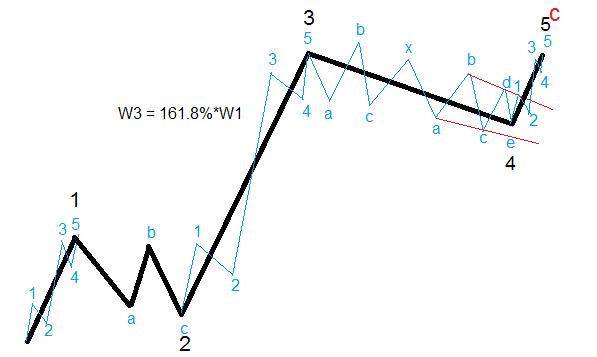
Remember the example we used when explaining the impulsive waves? It could very well be the c-wave of a flat or zigzag pattern or the a-wave of a zigzag.
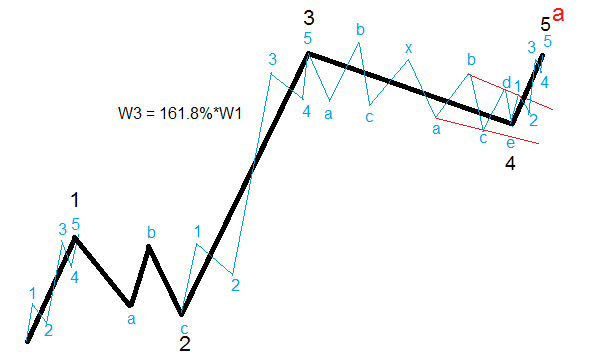
Simple Corrective Waves with the Elliott Waves Theory
Elliott found the market forms more corrective waves than impulsive ones. As such, he had a hard time labeling them, and a further division was necessary.
He divided corrective waves into simple and complex corrections, with only three types of simple corrections:
- Flat
- Zigzag
- Triangle
Flats in Forex Trading
A flat pattern is a simple correction, hence the labeling: a-b-c. A three-wave structure, a flat has the first two swings (waves a and b) corrective, and the c-wave impulsive.
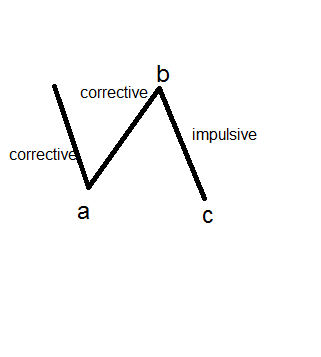
The c-wave, or the impulsive structure, must respect all the rules of an impulsive wave, as the previous article explained. If any one of the rules is broken, the c-wave is not impulsive, hence, the a-b-c above is not a flat pattern.
Because of its structure, traders refer to the flat pattern as a 3-3-5 formation, signaling the corrective and impulsive nature of its waves.
The key in a flat pattern stays with the b-wave: it must retrace more than 61.8% into the territory of the previous a-wave. If that does not happen, the pattern isn’t a flat.
Ten types of flat patterns exist. Based on the b-wave’s retracement level and the length of the c-wave, they represent the most numerous patterns in the Elliott Waves Theory.
For this reason, later in the Trading Academy, we’ll have an article dedicated entirely to the flat patterns, the various types that exist and what makes them so unique.
Here’s what to remember in a flat pattern:
- Waves a and b are corrective
- Only the c-wave is impulsive
- The b-wave retraces minimum 61.8% of the wave a
- The length of the c-wave gives the type of the flat pattern
Zigzags in Forex Trading
A zigzag is still a three-wave structure, still labeled with a-b-c, but it has two, instead of only one impulsive wave. Labeled by traders as a 5-3-5, it suggests the waves a and c have impulsive characteristics, while the b-wave is the only correction.
Like in the case of a flat pattern, the key stays with the b-wave. However, this time, the b-wave should not retrace more than 61.8% into the a-wave’s territory.
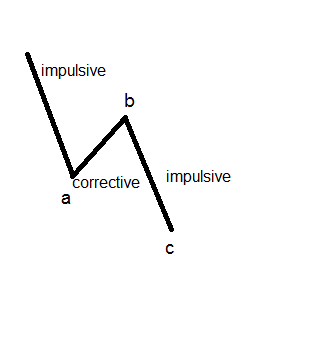
A zigzag is a vicious pattern. Because it has two impulsive waves (waves a and c), most of the times traders mistakenly interpret a zigzag as an impulsive structure.
We’ll have a closer look at the types of zigzags later, but for now keep in mind that:
- Waves a and c are impulsive waves
- The b-wave retraces less than 61.8% of wave a
- The b-wave must retrace minimum 1% of wave a
- The c-wave must exceed the end of wave a
Triangles with the Elliott Waves Theory
Triangles often appear in Forex trading. The favorite way for a market to consolidate, a triangle has five segments, labeled with letters: a-b-c-d-e.
All of them have a corrective nature. Hence, traders still call them “threes,” even though a triangle has five segments.
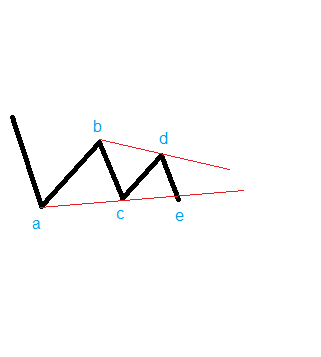
Elliott discovered multiple types of triangles, and you must keep in mind that he documented them on the stock market around the year 1930. In today’s Forex trading, the patterns differ, triangles have various shapes, but his ideas still make sense.
He divided triangles into different categories, like contracting and expanding (judging by the b-d and a-c trend lines), limiting and non-limiting, and even found some unique types of triangles.
In any case, with triangles being the favorite way for a market to consolidate, you can expect to meet them often in Forex trading.
Complex Corrective Waves with the Elliott Waves Theory
The three simple corrections from earlier are the basis of numerous complex corrections. In fact, rarely does the market form only a simple correction. That’s especially true in Forex trading, where innumerable swings make the market difficult to label.
A complex correction has at least one intervening wave, and a maximum of two. The intervening or connecting wave called an x-wave, is corrective too.
Imagine a flat, an x-wave and a zigzag. That’s called a double combination.
Or, a zigzag, an x-wave, and a triangle. That’s still a double combination.
If there’s another x-wave coming, the market forms a triple combination, the most complex pattern that Elliott labeled.
Conclusion
Because the market spends more time in consolidation, corrective waves dominate the price action. However, except for a triangle, all corrective waves have at least one impulsive move.
And, even in the case of a triangular formation, it is still possible to see impulsive activity. For example, if the a-wave of a triangle is a zigzag, then there are two impulsive waves of a lower degree present at the start of the triangle.
Slowly but surely, we have delved more in depth into the Elliott Waves Theory. Already things look a bit complicated, with so many rules to follow and exceptions to look for.
However, it is not by chance we covered these aspects in the Beginners section of this Trading Academy. Moving forward, you’ll see the Elliott Waves Theory further expands, with the possibility to incorporate even the time element into a forecast.

